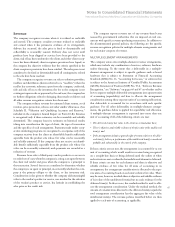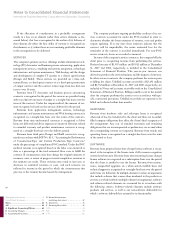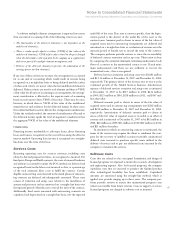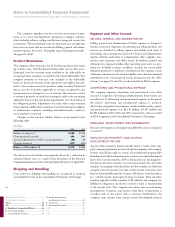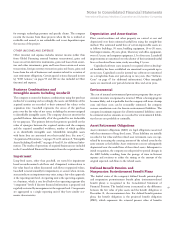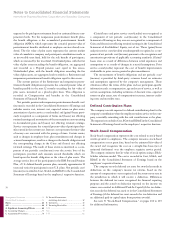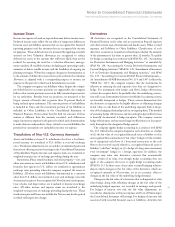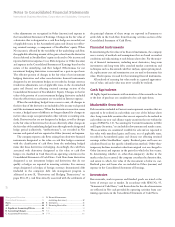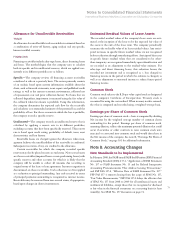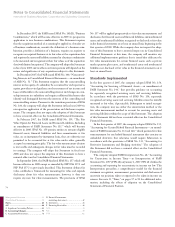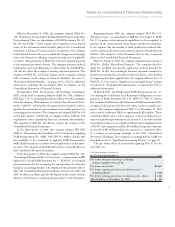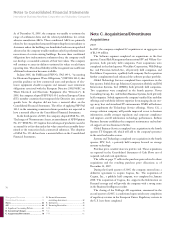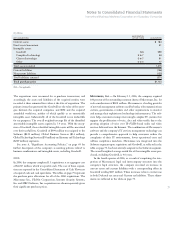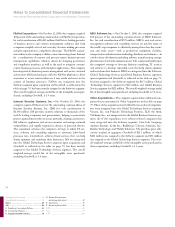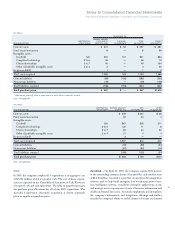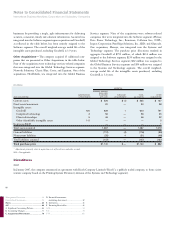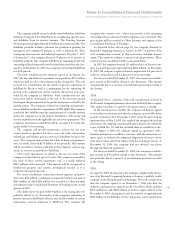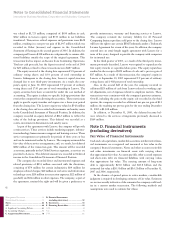IBM 2007 Annual Report Download - page 75
Download and view the complete annual report
Please find page 75 of the 2007 IBM annual report below. You can navigate through the pages in the report by either clicking on the pages listed below, or by using the keyword search tool below to find specific information within the annual report.73
Notes to Consolidated Financial Statements
International Business Machines Corporation and Subsidiary Companies
Allowance for Uncollectible Receivables
TRADE
An allowance for uncollectible trade receivables is estimated based on
a combination of write-off history, aging analysis and any specific,
known troubled accounts.
FINANCING
Financing receivables include sales-type leases, direct financing leases
and loans. The methodologies that the company uses to calculate
both its specific and its unallocated reserves, which are applied con-
sistently to its different portfolios are as follows:
Specific —The company reviews all financing account receivables
considered at risk on a quarterly basis. The review primarily consists
of an analysis based upon current information available about the
client, such as financial statements, news reports and published credit
ratings, as well as the current economic environment, collateral net
of repossession cost and prior collection history. For loans that are
collateral dependent, impairment is measured using the fair value of
the collateral when foreclosure is probable. Using this information,
the company determines the expected cash flow for the receivable
and calculates a recommended estimate of the potential loss and the
probability of loss. For those accounts in which the loss is probable,
the company records a specific reserve.
Unallocated —The company records an unallocated reserve that is
calculated by applying a reserve rate to its different portfolios,
excluding accounts that have been specifically reserved. This reserve
rate is based upon credit rating, probability of default, term, asset
characteristics and loss history.
Receivable losses are charged against the allowance when man-
agement believes the uncollectibility of the receivable is confirmed.
Subsequent recoveries, if any, are credited to the allowance.
Certain receivables for which the company recorded specific
reserves may also be placed on non-accrual status. Non-accrual assets
are those receivables (impaired loans or non-performing leases) with
specific reserves and other accounts for which it is likely that the
company will be unable to collect all amounts due according to
original terms of the lease or loan agreement. Income recognition is
discontinued on these receivables. Cash collections are first applied
as a reduction to principal outstanding. Any cash received in excess
of principal payments outstanding is recognized as interest income.
Receivables may be removed from non-accrual status, if appropriate,
based upon changes in client circumstances.
Estimated Residual Values of Lease Assets
The recorded residual values of the company’s lease assets are esti-
mated at the inception of the lease to be the expected fair value of
the assets at the end of the lease term. The company periodically
reassesses the realizable value of its lease residual values. Any antici-
pated increases in specific future residual values are not recognized
before realization through remarketing efforts. Anticipated decreases
in specific future residual values that are considered to be other-
than-temporary are recognized immediately upon identification and
are recorded as an adjustment to the residual-value estimate. For
sales-type and direct financing leases, this reduction lowers the
recorded net investment and is recognized as a loss charged to
financing income in the period in which the estimate is changed, as
well as an adjustment to unearned income to reduce future-period
financing income.
Common Stock
Common stock refers to the $.20 par value capital stock as designated
in the company’s Certificate of Incorporation. Treasury stock is
accounted for using the cost method. When treasury stock is reissued,
the value is computed and recorded using a weighted-average basis.
Earnings per Share of Common Stock
Earnings per share of common stock — basic is computed by dividing
Net income by the weighted average number of common shares
outstanding for the period. Earnings per share of common stock,
assuming dilution, reflects the maximum potential dilution that could
occur if securities or other contracts to issue common stock were
exercised or converted into common stock and would then share in
the Net income of the company. See note R, “Earnings Per Share of
Common Stock,” on page 101 for additional information.
Note B. Accounting Changes
New Standards to be Implemented
In February 2008, the FASB issued FASB Staff Position (FSP) Financial
Accounting Standard (FAS) 157-1, “Application of FASB Statement
No. 157 to FASB Statement No. 13 and Its Related Inter pretive
Accounting Pronouncements That Address Leasing Trans actions,”
and FSP FAS 157-2, “Effective Date of FASB Statement No. 157.”
FSP FAS 157-1 removes leasing from the scope of SFAS No. 157,
“Fair Value Measurements.” FSP FAS 157-2 delays the effective date
of SFAS No. 157 from 2008 to 2009 for all nonfinancial assets and
nonfinancial liabilities, except those that are recognized or disclosed
at fair value in the financial statements on a recurring basis (at least
annually). See SFAS No. 157 discussion on page 74.




